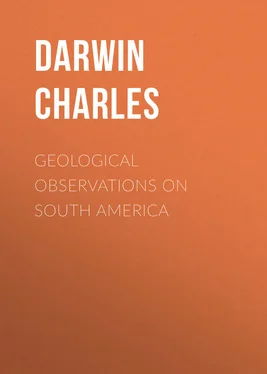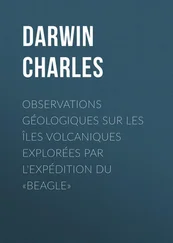Charles Darwin - Geological Observations on South America
Здесь есть возможность читать онлайн «Charles Darwin - Geological Observations on South America» — ознакомительный отрывок электронной книги совершенно бесплатно, а после прочтения отрывка купить полную версию. В некоторых случаях можно слушать аудио, скачать через торрент в формате fb2 и присутствует краткое содержание. Жанр: foreign_antique, foreign_prose, на английском языке. Описание произведения, (предисловие) а так же отзывы посетителей доступны на портале библиотеки ЛибКат.
- Название:Geological Observations on South America
- Автор:
- Жанр:
- Год:неизвестен
- ISBN:нет данных
- Рейтинг книги:3 / 5. Голосов: 1
-
Избранное:Добавить в избранное
- Отзывы:
-
Ваша оценка:
- 60
- 1
- 2
- 3
- 4
- 5
Geological Observations on South America: краткое содержание, описание и аннотация
Предлагаем к чтению аннотацию, описание, краткое содержание или предисловие (зависит от того, что написал сам автор книги «Geological Observations on South America»). Если вы не нашли необходимую информацию о книге — напишите в комментариях, мы постараемся отыскать её.
Geological Observations on South America — читать онлайн ознакомительный отрывок
Ниже представлен текст книги, разбитый по страницам. Система сохранения места последней прочитанной страницы, позволяет с удобством читать онлайн бесплатно книгу «Geological Observations on South America», без необходимости каждый раз заново искать на чём Вы остановились. Поставьте закладку, и сможете в любой момент перейти на страницу, на которой закончили чтение.
Интервал:
Закладка:
Many of these shells, as I have said, were packed in, and were quite filled with, blackish or reddish-brown earth, resting on the granitic detritus. I did not doubt until lately that this mould was of purely terrestrial origin, when with a microscope examining some of it from the inside of a Concholepas from the height of about one hundred feet, I found that it was in considerable part composed of minute fragments of the spines, mouth- bones, and shells of Echini, and of minute fragments, of chiefly very young Patellae, Mytili, and other species. I found similar microscopical fragments in earth filling up the central orifices of some large Fissurellae. This earth when crushed emits a sickly smell, precisely like that from garden-mould mixed with guano. The earth accidentally preserved within the shells, from the greater heights, has the same general appearance, but it is a little redder; it emits the same smell when rubbed, but I was unable to detect with certainty any marine remains in it. This earth resembles in general appearance, as before remarked, that capping the rocks of Quiriquina in the Bay of Concepcion, on which beds of sea-shells lay. I have, also, shown that the black, peaty soil, in which the shells at the height of 350 feet at Chiloe were packed, contained many minute fragments of marine animals. These facts appear to me interesting, as they show that soils, which would naturally be considered of purely terrestrial nature, may owe their origin in chief part to the sea.
Being well aware from what I have seen at Chiloe and in Tierra del Fuego, that vast quantities of shells are carried, during successive ages, far inland, where the inhabitants chiefly subsist on these productions, I am bound to state that at greater heights than 557 feet, where the number of very young and small shells proved that they had not been carried up for food, the only evidence of the shells having been naturally left by the sea, consists in their invariable and uniform appearance of extreme antiquity – in the distance of some of the places from the coast, in others being inaccessible from the nearest part of the beach, and in the absence of fresh water for men to drink – in the shells NOT LYING IN HEAPS, – and, lastly, in the close similarity of the soil in which they are embedded, to that which lower down can be unequivocally shown to be in great part formed from the debris of the sea animals. (In the "Proceedings of the Geological Society" volume 2 page 446, I have given a brief account of the upraised shells on the coast of Chile, and have there stated that the proofs of elevation are not satisfactory above the height of 230 feet. I had at that time unfortunately overlooked a separate page written during my second visit to Valparaiso, describing the shells now in my possession from the 557 feet hill; I had not then unpacked my collections, and had not reconsidered the obvious appearance of greater antiquity of the shells from the greater heights, nor had I at that time discovered the marine origin of the earth in which many of the shells are packed. Considering these facts, I do not now feel a shadow of doubt that the shells, at the height of 1,300 feet, have been upraised by natural causes into their present position.)
With respect to the position in which the shells lie, I was repeatedly struck here, at Concepcion, and at other places, with the frequency of their occurrence on the summits and edges either of separate hills, or of little flat headlands often terminating precipitously over the sea. The several above-enumerated species of mollusca, which are found strewed on the surface of the land from a few feet above the level of the sea up to the height of 1,300 feet, all now live either on the beach, or at only a few fathoms' depth: Mr. Edmondston, in a letter to Professor E. Forbes, states that in dredging in the Bay of Valparaiso, he found the common species of Concholepas, Fissurella, Trochus, Monoceros, Chitons, etc., living in abundance from the beach to a depth of seven fathoms; and dead shells occurred only a few fathoms deeper. The common Turritella cingulata was dredged up living at even from ten to fifteen fathoms; but this is a species which I did not find here amongst the upraised shells. Considering this fact of the species being all littoral or sub-littoral, considering their occurrence at various heights, their vast numbers, and their generally comminuted state, there can be little doubt that they were left on successive beach-lines during a gradual elevation of the land. The presence, however, of so many whole and perfectly preserved shells appears at first a difficulty on this view, considering that the coast is exposed to the full force of an open ocean: but we may suppose, either that these shells were thrown during gales on flat ledges of rock just above the level of high-water mark, and that during the elevation of the land they are never again touched by the waves, or, that during earthquakes, such as those of 1822, 1835, and 1837, rocky reefs covered with marine-animals were it one blow uplifted above the future reach of the sea. This latter explanation is, perhaps, the most probable one with respect to the beds at Concepcion entirely composed of the Mytilus Chiloensis, a species which lives below the lowest tides; and likewise with respect to the great beds occurring both north and south of Valparaiso, of the Mesodesma donaciforme, – a shell which, as I am informed by Mr. Cuming, inhabits sandbanks at the level of the lowest tides. But even in the case of shells having the habits of this Mytilus and Mesodesma, beds of them, wherever the sea gently throws up sand or mud, and thus protects its own accumulations, might be upraised by the slowest movement, and yet remain undisturbed by the waves of each new beach-line.
It is worthy of remark, that nowhere near Valparaiso above the height of twenty feet, or rarely of fifty feet, I saw any lines of erosion on the solid rocks, or any beds of pebbles; this, I believe, may be accounted for by the disintegrating tendency of most of the rocks in this neighbourhood. Nor is the land here modelled into terraces: Mr. Alison, however, informs me, that on both sides of one narrow ravine, at the height of 300 feet above the sea, he found a succession of rather indistinct step-formed beaches, composed of broken shells, which together covered a space of about eighty feet vertical.
I can add nothing to the accounts already published of the elevation of the land at Valparaiso, which accompanied the earthquake of 1822 (Dr. Meyen "Reise um Erde" Th. 1 s. 221, found in 1831 seaweed and other bodies still adhering to some rocks which during the shock of 1822 were lifted above the sea.): but I heard it confidently asserted, that a sentinel on duty, immediately after the shock, saw a part of a fort, which previously was not within the line of his vision, and this would indicate that the uplifting was not horizontal: it would even appear from some facts collected by Mr. Alison, that only the eastern half of the bay was then elevated. Through the kindness of this same gentleman, I am able to give an interesting account of the changes of level, which have supervened here within historical periods: about the year 1680 a long sea-wall (or Prefil) was built, of which only a few fragments now remain; up to the year 1817, the sea often broke over it, and washed the houses on the opposite side of the road (where the prison now stands); and even in 1819, Mr. J. Martin remembers walking at the foot of this wall, and being often obliged to climb over it to escape the waves. There now stands (1834) on the seaward side of this wall, and between it and the beach, in one part a single row of houses, and in another part two rows with a street between them. This great extension of the beach in so short a time cannot be attributed simply to the accumulation of detritus; for a resident engineer measured for me the height between the lowest part of the wall visible, and the present beach-line at spring-tides, and the difference was eleven feet six inches. The church of S. Augustin is believed to have been built in 1614, and there is a tradition that the sea formerly flowed very near it; by levelling, its foundations were found to stand nineteen feet six inches above the highest beach-line; so that we see in a period of 220 years, the elevation cannot have been as much as nineteen feet six inches. From the facts given with respect to the sea-wall, and from the testimony of the elder inhabitants, it appears certain that the change in level began to be manifest about the year 1817. The only sudden elevation of which there is any record occurred in 1822, and this seems to have been less than three feet. Since that year, I was assured by several competent observers, that part of an old wreck, which is firmly embedded near the beach, has sensibly emerged; hence here, as at Chiloe, a slow rise of the land appears to be now in progress. It seems highly probable that the rocks which are corroded in a band at the height of fourteen feet above the sea were acted on during the period, when by tradition the base of S. Augustin church, now nineteen feet six inches above the highest water-mark, was occasionally washed by the waves.
Читать дальшеИнтервал:
Закладка:
Похожие книги на «Geological Observations on South America»
Представляем Вашему вниманию похожие книги на «Geological Observations on South America» списком для выбора. Мы отобрали схожую по названию и смыслу литературу в надежде предоставить читателям больше вариантов отыскать новые, интересные, ещё непрочитанные произведения.
Обсуждение, отзывы о книге «Geological Observations on South America» и просто собственные мнения читателей. Оставьте ваши комментарии, напишите, что Вы думаете о произведении, его смысле или главных героях. Укажите что конкретно понравилось, а что нет, и почему Вы так считаете.












